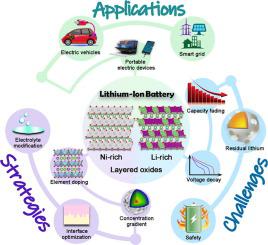当前位置:
X-MOL 学术
›
Mater. Today
›
论文详情
Our official English website, www.x-mol.net, welcomes your
feedback! (Note: you will need to create a separate account there.)
Recent breakthroughs and perspectives of high-energy layered oxide cathode materials for lithium ion batteries
Materials Today ( IF 21.1 ) Pub Date : 2020-11-01 , DOI: 10.1016/j.mattod.2020.10.028 Junxiang Liu , Jiaqi Wang , Youxuan Ni , Kai Zhang , Fangyi Cheng , Jun Chen
Materials Today ( IF 21.1 ) Pub Date : 2020-11-01 , DOI: 10.1016/j.mattod.2020.10.028 Junxiang Liu , Jiaqi Wang , Youxuan Ni , Kai Zhang , Fangyi Cheng , Jun Chen

|
Abstract Ni-rich layered oxides (NRLOs) and Li-rich layered oxides (LRLOs) have been considered as promising next-generation cathode materials for lithium ion batteries (LIBs) due to their high energy density, low cost, and environmental friendliness. However, these two layered oxides suffer from similar problems like capacity fading and different obstacles such as thermal runaway for NRLOs and voltage decay for LRLOs. Understanding the similarities and differences of their challenges and strategies at multiple scales plays a paramount role in the cathode development of advanced LIBs. Herein, we provide a comprehensive review of state-of-the-art progress made in NRLOs and LRLOs based on multi-scale insights into electrons/ions, crystals, particles, electrodes and cells. For NRLOs, issues like structure disorder, cracks, interfacial degradation and thermal runaway are elaborately discussed. Superexchange interaction and magnetic frustration are blamed for structure disorder while strains induced by universal structural collapse result in issues like cracks. For LRLOs, we present an overview of the origin of high capacity followed by local crystal structure, and the root of voltage hysteresis/decay, which are ascribed to reduced valence of transition metal ions, phase transformation, strains, and microstructure degradation. We then discuss failure mechanism in full cells with NRLO cathode and commercial challenges of LRLOs. Moreover, strategies to improve the performance of NRLOs and LRLOs from different scales such as ion-doping, microstructure designs, particle modifications, and electrode/electrolyte interface engineering are summarized. Dopants like Na, Mg and Zr, delicate gradient concentration design, coatings like spinel LiNi0.5Mn1.5O4 or Li3PO4 and novel electrolyte formulas are highly desired. Developing single crystals for NRLOs and new crystallographic structure or heterostructure for LRLOs are also emphasized. Finally, remaining challenges and perspectives are outlined for the development of NRLOs and LRLOs. This review offers fundamental understanding and future perspectives towards high-performance cathodes for next-generation LIBs.
中文翻译:

锂离子电池高能层状氧化物正极材料的近期突破与展望
摘要 富镍层状氧化物(NRLOs)和富锂层状氧化物(LRLOs)由于其能量密度高、成本低和环境友好而被认为是有前途的下一代锂离子电池(LIBs)正极材料。然而,这两种层状氧化物存在类似的问题,如容量衰减和不同的障碍,如 NRLO 的热失控和 LRLO 的电压衰减。了解它们在多个尺度上的挑战和策略的异同在先进 LIB 的阴极开发中起着至关重要的作用。在此,我们基于对电子/离子、晶体、粒子、电极和细胞的多尺度洞察,全面回顾了 NRLO 和 LRLO 的最新进展。对于 NRLO,诸如结构紊乱、裂缝、详细讨论了界面退化和热失控。超交换相互作用和磁挫败被归咎于结构紊乱,而普遍结构倒塌引起的应变会导致裂缝等问题。对于 LRLO,我们概述了高容量的起源,然后是局部晶体结构,以及电压滞后/衰减的根源,这归因于过渡金属离子的化合价、相变、应变和微观结构退化。然后我们讨论了带有 NRLO 阴极的全电池的失效机制和 LRLO 的商业挑战。此外,还总结了从离子掺杂、微观结构设计、粒子改性和电极/电解质界面工程等不同尺度提高 NRLO 和 LRLO 性能的策略。像Na这样的掺杂剂,Mg 和 Zr、精细的梯度浓度设计、尖晶石 LiNi0.5Mn1.5O4 或 Li3PO4 等涂层和新型电解质配方是非常需要的。还强调了为 NRLO 开发单晶和为 LRLO 开发新的晶体结构或异质结构。最后,概述了发展 NRLO 和 LRLO 的剩余挑战和前景。该综述提供了对用于下一代 LIB 的高性能阴极的基本理解和未来展望。概述了发展 NRLO 和 LRLO 的剩余挑战和前景。该综述提供了对用于下一代 LIB 的高性能阴极的基本理解和未来展望。概述了发展 NRLO 和 LRLO 的剩余挑战和前景。该综述提供了对用于下一代 LIB 的高性能阴极的基本理解和未来展望。
更新日期:2020-11-01
中文翻译:

锂离子电池高能层状氧化物正极材料的近期突破与展望
摘要 富镍层状氧化物(NRLOs)和富锂层状氧化物(LRLOs)由于其能量密度高、成本低和环境友好而被认为是有前途的下一代锂离子电池(LIBs)正极材料。然而,这两种层状氧化物存在类似的问题,如容量衰减和不同的障碍,如 NRLO 的热失控和 LRLO 的电压衰减。了解它们在多个尺度上的挑战和策略的异同在先进 LIB 的阴极开发中起着至关重要的作用。在此,我们基于对电子/离子、晶体、粒子、电极和细胞的多尺度洞察,全面回顾了 NRLO 和 LRLO 的最新进展。对于 NRLO,诸如结构紊乱、裂缝、详细讨论了界面退化和热失控。超交换相互作用和磁挫败被归咎于结构紊乱,而普遍结构倒塌引起的应变会导致裂缝等问题。对于 LRLO,我们概述了高容量的起源,然后是局部晶体结构,以及电压滞后/衰减的根源,这归因于过渡金属离子的化合价、相变、应变和微观结构退化。然后我们讨论了带有 NRLO 阴极的全电池的失效机制和 LRLO 的商业挑战。此外,还总结了从离子掺杂、微观结构设计、粒子改性和电极/电解质界面工程等不同尺度提高 NRLO 和 LRLO 性能的策略。像Na这样的掺杂剂,Mg 和 Zr、精细的梯度浓度设计、尖晶石 LiNi0.5Mn1.5O4 或 Li3PO4 等涂层和新型电解质配方是非常需要的。还强调了为 NRLO 开发单晶和为 LRLO 开发新的晶体结构或异质结构。最后,概述了发展 NRLO 和 LRLO 的剩余挑战和前景。该综述提供了对用于下一代 LIB 的高性能阴极的基本理解和未来展望。概述了发展 NRLO 和 LRLO 的剩余挑战和前景。该综述提供了对用于下一代 LIB 的高性能阴极的基本理解和未来展望。概述了发展 NRLO 和 LRLO 的剩余挑战和前景。该综述提供了对用于下一代 LIB 的高性能阴极的基本理解和未来展望。









































 京公网安备 11010802027423号
京公网安备 11010802027423号